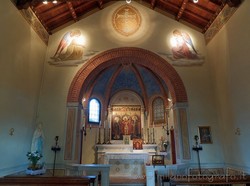|
Brugherio (Monza e Brianza, Italy): Church of Sant'Ambrogio
|
|
|
Show an other place around Milan worth a visit: |
 The Church of Sant'Ambrogio and the homonymous farmhouse to which it belongs (the farmhouse has now been transformed into a residential complex) were once part of a monastery built in the villa which according to tradition was owned by St. Ambrose bishop of Milan and that he gave to his older sister, Santa Marcellina, so that she and other noble virgins could have a place where to practice their life dedicated to God. It should be noted that another brother of Ambrose, Satyr, also became a saint. The Church of Sant'Ambrogio and the homonymous farmhouse to which it belongs (the farmhouse has now been transformed into a residential complex) were once part of a monastery built in the villa which according to tradition was owned by St. Ambrose bishop of Milan and that he gave to his older sister, Santa Marcellina, so that she and other noble virgins could have a place where to practice their life dedicated to God. It should be noted that another brother of Ambrose, Satyr, also became a saint.
Ambrose would have donated to his sister also three relics, consisting of fragments of the fingers of the three Magi, whose remains were kept in the Basilica of Sant'Eustorgio. These fragments were then, over time, forgotten in a niche of the church, until they were rediscovered in 1596 by Cardinal Federico Borromeo during a visit. Once their nature was recognized, after careful investigations, in 1613 they were moved to the parish church of San Bartolomeo where they still can be found today.
Over the centuries, various orders alternated in possession of the monastery: Benedictine, Augustinian and finally Humiliated. In 1539, however, the nuns moved to the monastery of Santa Caterina la Chiusa in Milan, while still maintaining the ownership of the monastery and all the benefits and rights deriving from it.
Following the suppression of the monastic orders in the Napoleonic era, the farmhouse with the adjoining church were sold to privates.
It should be emphasized that what is today the Church of Sant'Ambrogio was originally only a large chapel of the actual church, a chapel closed to the public and open only to th nuns. That is, it was the hall of the nuns of the church.
In 1846 the public part of the church was demolished and what was previously only a chapel became itself the Church of Sant'Ambrogio.
It should be emphasized that although the church was probably built in the twelfth century, its appearance is substantially nineteenth-century.
The church has a single room with a deep polygonal apse and a gabled vault supported by wooden trusses with decorated frames.
The neo-Romanesque façade was built in the second half of the nineteenth century. The architrave of the entrance door, however, comes from the original church and is therefore from the early Middle Ages. On it appear in bas-reliefs the Lion and the Eagle, symbols of the Evangelists Mark and John, and. in the center, a Greek Cross. The mosaic in the lunette above it is instead modern, having been made in 1953.
The apse is divided from the nave by a round arch, underlined by a brick frame Above the arch there the frescoes of two praying angels and of the Salus mundi radiated cross. These too are recent.
The vault of the apse is divided in starry blue segments by brick ribs and overlooks a stone altar on which appears a copy of the precious fifteenth-century altarpiece depicting Christ, Sant'Ambrogio and Sant'Agostino. The original work is kept by the Dubini family, owners of the complex since 1903. It should be noted that only one of the two windows in the presbytery wall is real. The other, the one on the right, was painted in order to recreate an apparent symmetry.
The only ancient decorations still present in the church are the fifteenth-century frescoes painted by an anonymous country master. They are located on the side walls near the entrance and were rediscovered in 1953 following the restorations carried out that year. In the fresco on the left, San Sebastian at the column and the blessing martyr Pope Fabianus appear (Fig. 3). The one on the right shows the three brothers Saints Ambrose, Marcellina and Satirus (Fig. 4). Their state of conservation is not optimal, but the figures represented are still well recognizable. It should be noted that, unlike usual, Ambrose is not depicted as an old man with a beard but young and beardless.
The Church of Sant'Ambrogio in Brugherio can be visited in conjunction with cultural events such as, in particular, Ville Aperte in Brianza .
Categories: Places of historical value
Via dei Mille, 112, 20861 Brugherio MB |
Further pictures of Church of Sant'Ambrogio in the section Photography |